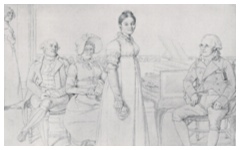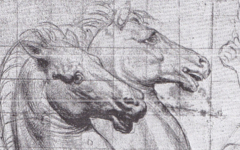Ingres’ Napoleon I on His Imperial Throne (1806)

Ingres, Napoleon I on His Imperial Throne (1806) Oil on canvas. Musée d l'Armée, Les Invalides, Paris.
Click image to enlarge.
Ingres' painting of Napoleon is a striking picture. When I first thought of comparing the face in it to Ingres' self-portrait, it was the first I did of an important historical character portrayed by other painters too. I was surprised. I then wondered whether Napoleon's other portraits would resemble the artist who painted it. And, surprisngly, they do. This raised a significant issue. If portraits of the same person by Ingres, David, Gros, Girodet, Delaroche and Appiani, each resemble the artist then the ingrained belief that Old Master portraits were intended as accurate likenesses is questionable. I already suspected other genres of art were not depictions of exterior reality. Now nor were portraits.1
Click next thumbnail to continue
Why these faces look alike is uncertain because the self-portrait is from 30 years later.1 In any event Ingres could not have depicted Napoleon with any accuracy, i.e., from life, because he was young and un-commissioned. A Government inspector later said so, reporting that the finished picture did not resemble the Emperor.2
See conclusion below
It seems quite certain then that Ingres included some of his own features in Napoleon and then, years later, made his apparent self-portrait resemble his earlier depiction of the emperor. This probably means that Napoleon in the painting represents an “artist” while Ingres in the drawing conveys the aura of an “Emperor.” Either way Ingres' face-as-Napoleon's implies the figure is an "emperor of art", an imagined archetype perhaps of the honor to which French artists aspire. He planned, furthermore, to have the later self-portrait engraved and distributed to all his students of which there were more than one hundred.3 Was it perhaps an attempt to have his features as Napoleon morphed into future art by his students, some of whom were destined for greatness themselves?
There is a postscript to the story. In a book published in 1856 Théophile Silvestre recounts a conversation with one of Ingres' pupils who told him, "It is impossible to compare our master to any other man than Napoleon I." Silvestre then comments that Ingres did indeed resemble the Emperor: "There is in [his] physiognomy, in the gestures, something to that."4 I believe that Silvestre, too young to have seen Napoleon in life, was comparing Ingres' features to Ingres' own portrait of Napoleon. Ingres would probably have been pleased.
See also the entry on Gros' portrait of Napoleon.
More Works by Ingres
Notes:
1. See comparisons of Napoleon by other artists, and of other sitters, in the EPPH book Every Painter Paints Himself: Portraits of An Artist and An Alter Ego.
2. In most other portrait/self-portrait comparisons on EPPH the self-portrait is generally earlier.
3. Gary Tinterow and Philip Conisbee. (eds.) Portraits by Ingres: Image of an Epoch (New York: Metropolitan Museum of Art) 1999, p.69
4. Silvestre, Histoires des artistes vivants: Études d'après nature (Paris) 1856, p.5 cited in Edgar Munhall, Ingres and the Comtesse d"Haussonville (New York: Frick) 1985, p.16
5. Silvestre, ibid., p.18
Original Publication Date on EPPH: 12 Sep 2010. | Updated: 0. © Simon Abrahams. Articles on this site are the copyright of Simon Abrahams. To use copyrighted material in print or other media for purposes beyond 'fair use', you must obtain permission from the copyright owner. Websites may link to this page without permission (please do) but may not reproduce the material on their own site without crediting Simon Abrahams and EPPH.




